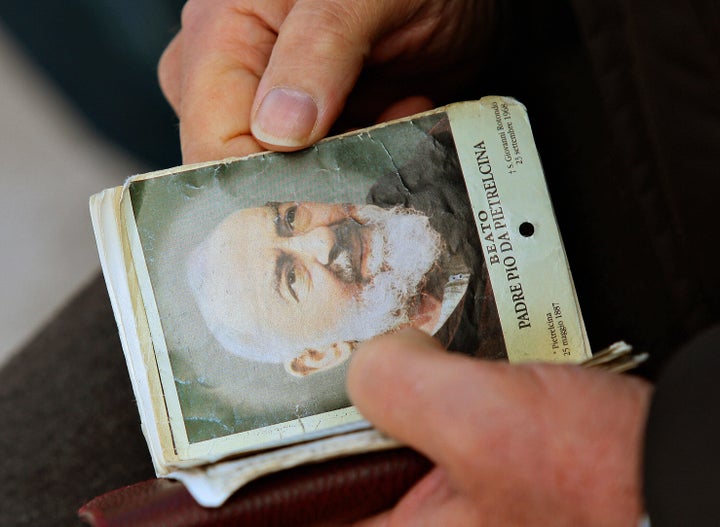
Padre Pio is a hero of mine. I am not a Catholic, but Jewish by birth, and a lifelong student of global spirituality. I lived in India for five years and wrote two books about revered teachers in the Hindu tradition. It was in India that I learned about Padre Pio from an Italian woman, who was visiting some ashrams there. She told me about this mysterious monk, revered by millions, who lived a cloistered life in southern Italy, and she gave me a small picture of the holy man with a piece of one of his gloves glued to the card.
Padre Pio's gloves are regarded as sacred relics, because he wore them to protect his hands, which bled for most of his adult life from two puncture wounds which never healed, and which his followers regarded as the stigmata of Christ. Padre Pio, who died in 1968 at the age of 81, was granted the stigmata, by his own testimony, when Jesus appeared to him in a vision and invited the young monk to share in his redemptive suffering.
The first recorded stigmatist was Saint Francis of Assisi, whose hands, feet and side began seeping blood after an angel reputedly pierced him with Christ's wounds in 1224 two years before his death. Some have attributed the stigmata of Francis and many other saints to hysteria.
From my own investigation of Hindu mystics, however, I have come to believe that such phenomena are the result of an intense mystical identification. As I reported in my own book on him, the renowned holy man of nineteenth century Calcutta, Sri Ramakrishna Paramahamsa, is said to have grown breasts when he identified with Radha, the consort of Krishna, in his devotions, and to have sprouted a residual tail when he worshipped Hanuman, the monkey servant of Lord Rama.
I have personally witnessed Sufis stick knives through their cheeks, without any flow of blood or obvious discomfort, while they were in trance. I also watched a living stigmatist, the Syrian Orthodox Sister Susan Kuruvilla in Kerala south India, undergo her weekly "passion of Christ," in which she writhed on her bed in pain as her palms and forehead visibly reddened (but did not bleed.)
One need not ascribe a supernatural or miraculous cause for such events. They may demonstrate the mind's remarkable power to impact the body. Recent medical research has confirmed the intimate connection between our thought processes and our physical state.
On the other hand, the stigmata might -- as believers assert -- be a token of mystic elevation and divine favor. In any event, the reality of the phenomena is disputed even by some devout Catholics. So it is understandable that, at first, Padre Pio's religious superiors were skeptical. By order of the Vatican, the monk was kept under strict observation to determine if his wounds were self-inflicted. These early restrictions were eventually lifted, and he was allowed to celebrate mass (which often lasted for hours when Padre Pio went into ecstasy) and hear the confessions of the local laypeople, who began flocking to the "saint" for his blessings and spiritual counsel.
What attracted me to Padre Pio was not his stigmata, or the other reputed miracles like levitation, bilocation and gifts of healing, but a quality of humility and deep compassion that I could sense when I looked at photographs of him, or read his simple yet profound words. "Pray, hope, and don't worry," he famously advised. Padre Pio parted with orthodox Catholic doctrine in holding that sincere people of all faiths would be "saved." And while suffering clearly played an important role in his own spiritual journey, the monk prophesied that in the future joy rather than affliction would bring people to God.
Still, Padre Pio remains a controversial figure for many. So I was not surprised when a friend and fellow blogger emailed me a link to an article in the Huffington Post, which repeats a claim by professor Sergio Luzzatto in his book entitled, Miracles and Politics in a Secular Age, that Padre Pio created the stigmata wounds by applying Carbolic acid to his skin. This allegation was first made 88 years ago, and investigated by the Vatican, which found it baseless.
Nobody disputes Luzzato's claim that Padre Pio ordered carbolic acid for the priory. In his 2005 book, Padre Pio and America, however, author Frank Rega reveals what the acid was actually used for:
"The boys had needed injections to fight the Spanish Flu which was raging at that time. Due to a shortage of doctors, Padres Paolino and Pio administered the shots, using carbolic acid as a sterilizing agent."
Carbolic acid eats away at biological tissues and produces large and irregular rashes and eventually rotting of the flesh and necrosis in areas where it has been applied -- neither of which were observed in Padre Pio's case. His wounds remained throughout his life small and localized and did not spread.
As a reporter, I have been trained to check the facts. Was Padre Pio a divinely inspired holy man with supernatural powers? No mere journalist can presume to say. Did he create his own wounds for 60 plus years using carbolic acid? Not likely.